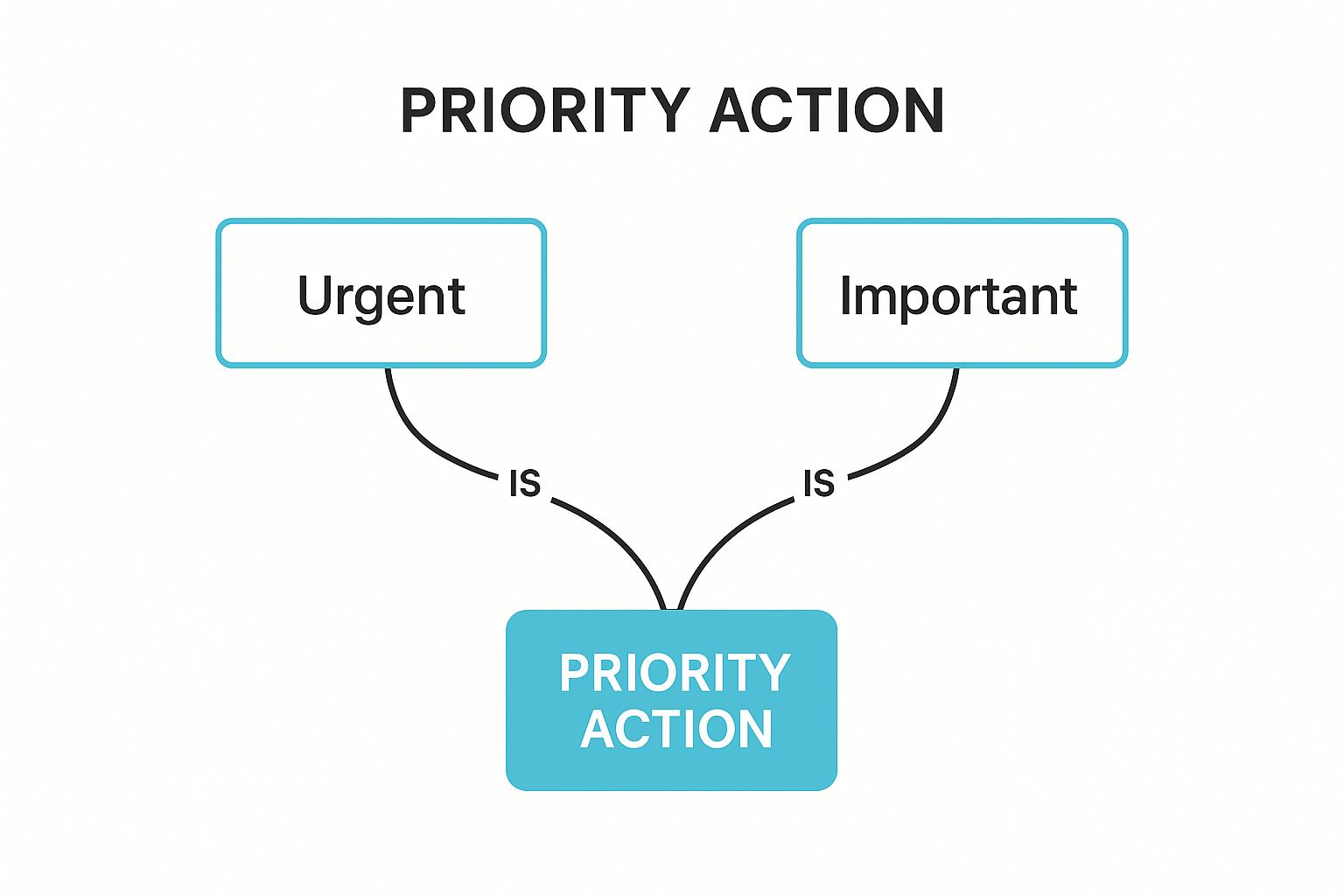Does your day feel like a race you can't win? You make a list, but it just gets longer. You are busy all day, but what did you really finish? The problem is not that you don't have enough time. It's about how you use it. We are going to learn some very simple but strong tricks. These are the real best practices for time management that smart people use to get more done and feel less stressed.
These are not boring rules. They are like secret codes to get more time for things you love. Instead of just making another to-do list, you will learn how to make a smart plan that works for you. It can help you if you are a doctor writing notes, a boss with big projects, or anyone trying to finish work.
This guide will give you real things you can do today. You will learn how to pick what is most important. You will learn how to beat waiting around by starting with the hard jobs first. You'll also learn how to plan your day so you are in charge. Let's learn how to tell your time what to do, instead of it telling you.
1. The Pomodoro Technique
The Pomodoro Technique is a great way to get things done without getting tired. A man named Francesco Cirillo made it. You use a timer to break your work into small chunks. You work hard for 25 minutes, then take a short 5-minute break. This 25-minute work time is called one "Pomodoro." That is the Italian word for tomato.


After you do four Pomodoros (which is about two hours), you get a longer break of 15 to 30 minutes. This way of working and resting helps your brain stay fresh. It helps you focus. That makes it a great way to manage time.
Who Should Use This Trick?
This trick is great for big jobs that feel too hard. For example, a doctor writing long notes for a patient can use it to stay focused between seeing people. A person who builds computer programs can use it to write tricky code without getting distracted. It is also good for anyone who has a hard time starting a project.
How to Make It Work for You
It is easy to start. These tips will help you get good at one of the best practices for time management:
- Turn off noise. When you work for 25 minutes, make your phone quiet. Close extra pages on your computer.
- Use a real timer. A kitchen timer is better than a phone app. It won't show you games or messages.
- Make breaks real breaks. Get up and stretch. Get a glass of water. Do not just check your email.
- Start with short times. If 25 minutes is too long, try 15 minutes of work with a 3-minute break. You can do more later.
2. Time Blocking and Calendar Blocking
Time blocking is when you plan every part of your day. Instead of a simple to-do list, you give each job its own "block" of time on your calendar. You plan exactly when you will do something. This turns your calendar into a map for your day and is one of the best practices for time management.


It is like making appointments with yourself. You would not miss a meeting with your boss. In the same way, you will not skip the time you planned for a big project. Famous leaders like Elon Musk and Bill Gates use this trick to run their busy days.
Who Should Use This Trick?
This trick is perfect for people with many different kinds of jobs. A person in charge of a product can block time for team meetings, talking to customers, and planning. A lawyer can block time for looking up cases, calling clients, and writing papers. This helps make sure nothing is missed. It helps anyone who needs to save time for quiet, deep work.
How to Make It Work for You
It is simple to start time blocking. Follow these tips to be in charge of your day:
- Start with bigger blocks. Plan your jobs in 30 or 60-minute blocks first. You can make them smaller later.
- Color your jobs. Use different colors on your calendar for meetings, quiet work, and free time. This helps you see where your time goes.
- Leave empty space. Add 10-minute empty blocks between your jobs. This gives you time to stretch, get a drink, or handle small surprises.
- Plan your week ahead. On Friday or Sunday, plan your blocks for the next week. This helps you and your team know what to expect. This can also improve team efficiency.
3. The Eisenhower Matrix (Urgent-Important Box)
The Eisenhower Matrix is a smart way to decide what to do first. President Dwight D. Eisenhower used it. This trick helps you sort your jobs by how urgent and important they are. It makes four boxes: Do First, Plan to Do, Give to Someone Else, and Don't Do. This helps you stop doing busy work and focus on what is really important.
This map shows you how the two ideas work together to pick what you should do next.


When you know how these two ideas connect, you can make clear choices. Using this plan is one of the best practices for time management because it helps you be truly productive, not just busy.
Who Should Use This Trick?
This trick is perfect for leaders and bosses who have many things to do. A hospital boss can use it to choose between a patient complaint (urgent and important) and planning a budget meeting (important but not urgent). A project leader can use it to sort team jobs and finish on time.
How to Make It Work for You
Sorting your jobs is simple. These tips will help you use the boxes well:
- Be honest. Is a job really important? Or does it just feel urgent because someone is asking for it loudly? Think for a moment before you sort it.
- Stay in the "Plan to Do" box. Your most important work, like learning new things, lives in this box. Try to spend most of your time here.
- Learn to say no. Many jobs go in the "Don't Do" box. It is okay to not do things that do not help you reach your goals.
- Check it every day. What's important can change fast. Look at your boxes each morning to be sure you are working on the right things.
4. Getting Things Done (GTD) System
The Getting Things Done (GTD) system is a way to handle all your jobs by getting them out of your head. David Allen made it up. This trick helps you stop worrying about what you need to do. You write down every idea and job in a safe place, like a notebook or an app.
The main idea is to look at everything you wrote down and decide the very next step to move it forward. This clears your mind so you can focus on the job you are doing right now. It is one of the best practices for time management for people with many things to do.
Who Should Use This Trick?
This system is perfect for people who have a lot going on. A person who helps different companies can use GTD to track every project. A person starting their own company can use it to remember all the jobs for selling, making, and marketing their product. It is also great for professors who have to do research, teach classes, and go to meetings.
How to Make It Work for You
GTD can feel big, but these tips make it simple. It can also help improve team productivity:
- Just write it down. Before you do anything else, get good at writing down every idea or job that pops into your head.
- Use simple tools. Start with a plain notebook or a simple app on your phone and computer. Do not waste time looking for the "perfect" tool.
- Do a weekly check-in. This is the most important part. Set aside time each week to look at all your lists, clean them up, and plan for the next week.
- Make lists for places. Make lists for where you do your work. For example, "@Office," "@Phone," or "@Home." This helps you only see the jobs you can do right now.
5. The Two-Minute Rule
The Two-Minute Rule is a simple but strong idea to stop small jobs from piling up. David Allen made it popular. The rule is very easy: if a new job takes less than two minutes, do it right away. Do not put it off for later.
This trick helps you clear away the little things that fill up your mind and your to-do list. When you do quick jobs right away, you feel good and keep your desk and schedule clean. This is one of the easiest and best practices for time management you can use today.
Who Should Use This Trick?
This rule is perfect for busy people who get lots of small requests. A person in charge of a product can use it to answer quick questions on a chat app right when they see them. A person who works with the law can use it to file a signed paper right after a meeting, so it doesn't get lost. It is also great for anyone who feels like they have too many tiny jobs to do.
How to Make It Work for You
Making the Two-Minute Rule a habit is simple. These tips will help you use it well:
- Be real about the time. If a job will really take five minutes, plan a time to do it. Do not trick yourself into starting a bigger job.
- Don't stop deep work. If you are in the middle of a hard job, save your two-minute jobs for later. This rule is best for when you are between big tasks.
- Make a "quick job" time. Set aside 15 minutes a day to do a bunch of these small jobs all at once.
- Think of it like cleaning as you go. You wipe the counter after making a snack. In the same way, doing small work jobs right away keeps things neat.
6. Eat That Frog (Do Your Biggest Job First)
The "Eat That Frog" trick is a simple but strong way to plan your day. The writer Brian Tracy made it popular. The idea comes from a Mark Twain quote: if you eat a live frog first thing in the morning, the rest of your day will be easy. Your "frog" is your biggest, most important job. It is the one you are most likely to put off.


By finishing this hard job first, you use your morning energy when it is highest. This makes you feel good and gives you energy for the rest of the day. It is one of the best practices for time management.
Who Should Use This Trick?
This trick is perfect for people who put off important work. A salesperson can use it to make their hardest phone calls first. A writer can use it to work on a hard chapter before doing easier edits. It is also great for bosses who need to think about big plans before the day's small problems show up.
How to Make It Work for You
Using this idea is easy. These tips will help you make it a habit:
- Find your "frog." Before you finish work for the day, decide what your most important job is for tomorrow.
- Get ready the night before. Get everything you need for your frog job ready. Then you can start right away in the morning.
- Save your best time. Block off the first hour of your day. Do not have meetings or check emails during this time.
- Cut big frogs into small pieces. If a job feels too big, break it into smaller steps. Then, start with the first step.
- Celebrate your win. After you eat your frog, feel good about it! This little reward helps you keep doing it.
7. The 80/20 Rule (Pareto Principle)
The 80/20 Rule is a simple idea that can change your day. It is also called the Pareto Principle. It says that about 80% of your good results come from only 20% of your work. If you find and focus on that small but powerful 20%, you can do more in less time.
This idea helps you stop wasting energy on jobs that don't make a big difference. You put your effort where it really matters. This makes it one of the smartest best practices for time management. It is about working smarter, not just harder.
Who Should Use This Trick?
This rule is great for anyone who feels busy but not like they are getting things done. A person in charge of a product can see that 20% of a program's tools are used by 80% of people. This helps them pick what to fix first. A doctor might see that 20% of their jobs, like checking on important test results, stop 80% of future problems.
How to Make It Work for You
Finding your most important 20% is the key. These tips will help you use this rule:
- List your jobs. At the start of the week, write down everything you have to do. Then, circle the few jobs that will give you the biggest results.
- Focus on that 20%. Do those important jobs first, when you have the most energy.
- Let go of the rest. Learn to say no, give jobs to other people, or just stop doing the small jobs that take up your time.
- Check your results. Look at what you did. Is the 80/20 rule still working for you? Your important jobs might change over time.
8. Single-Tasking and Deep Work
Single-tasking means doing just one thing at a time with all your attention. It is the opposite of trying to do many things at once, which can lead to mistakes. Deep work is a special kind of single-tasking. It means you focus without any distractions to do hard things that are very important.
This means giving all your brainpower to one big job. By blocking out noise, you can think more clearly and do better work in less time. This focus is a key part of using your time well because it helps you finish your most important work faster.
Who Should Use This Trick?
Deep work is perfect for jobs that need a lot of brainpower. An author writing a book can use it to finish a chapter without stopping. A lawyer can use it to study a hard case with full attention. It is also great for a product manager who needs to plan a big project without being pulled into meetings.
How to Make It Work for You
Starting deep work is a great way to get more done. These tips will help you make single-tasking one of your best practices for time management:
- Set a special time. Block out "deep work" time on your calendar. Tell your team you will not be available.
- Make a no-distraction space. Put your phone in another room. Close all computer pages that are not for your main job.
- Start small. If 90 minutes feels too long, start with a focused 30-minute time. You can do more later.
- Plan your focus. Decide exactly what you will work on before you start. This way you don't waste time figuring it out. Learn more about how to increase productivity to get good at this.
- Have a shutdown habit. When your time is up, have a simple way to end, like cleaning your desk. This tells your brain it's okay to switch to something else.
9. Weekly and Daily Planning Reviews
Weekly and daily planning reviews are a smart way to stay on track. This trick means you set aside time each week and each day to look at what you have done and plan what is next. A weekly review helps you see the big picture. A daily review helps you focus on your most important jobs for the day.
This two-part system helps you think and plan. By checking on your work and changing your plans, you can be sure you are always working on the right things. This is a key part of many good time management plans. It helps you feel in control, not like you have too much to do.
Who Should Use This Trick?
This trick is perfect for anyone with many projects or goals. A project manager can use a weekly review to check if a project is going well and plan the next week's jobs. A company leader can use it to make sure their team's work helps the company. It is also great for a student planning their study time each Sunday for the week's classes.
How to Make It Work for You
Making this a habit is simple. These tips will help you get good at one of the best practices for time management:
- Plan your reviews. Treat your weekly and daily planning times like important meetings. Put them in your calendar.
- Use a simple checklist. For your weekly review, ask: What went well? What did not? What is most important for next week?
- Get ready the night before. Take five minutes before you stop working to plan your top three jobs for the next day. This helps you start your morning with a clear plan.
- Keep it short. A weekly review might take 30 minutes. A daily plan can be done in just five minutes. The goal is to be focused, not to spend hours planning.
Best Practices for Time Management: 9-Method Comparison
| Technique | Implementation Complexity | Resource Requirements | Expected Outcomes | Ideal Use Cases | Key Advantages |
|---|---|---|---|---|---|
| The Pomodoro Technique | Low | Timer (physical or app) | Improved focus, reduced fatigue | Tasks needing bursts of focused work | Easy to implement, tracks productivity |
| Time Blocking and Calendar Blocking | Medium | Digital or physical calendar | Realistic time management, reduced multitasking | Knowledge workers, executives, multitaskers | Visual schedule, reduces decision fatigue |
| Eisenhower Matrix (Urgent-Important Matrix) | Low | Paper/digital matrix or app | Clear task prioritization, focus on value | Task prioritization, strategic planning | Simple, clarifies urgent vs important tasks |
| Getting Things Done (GTD) System | High | Digital/tools for capturing and tracking | Reduced mental load, organized task management | Complex workflows, multiple projects | Comprehensive, adaptable system |
| The Two-Minute Rule | Very Low | None | Prevention of task buildup, momentum | Small, quick tasks across contexts | Simple, immediate action principle |
| Eat That Frog | Low | Minimal (planning tool optional) | Early completion of major tasks | Important/difficult task prioritization | Builds momentum, reduces procrastination |
| The 80/20 Rule (Pareto Principle) | Medium | Analytical tools optional | Increased efficiency by focusing on vital few | Business, personal productivity, strategic focus | Maximizes results with minimal effort |
| Single-Tasking and Deep Work | Medium to High | Distraction-free environment | High-quality output, skill development | Knowledge work, creative and cognitive-demanding tasks | Enhances productivity and focus |
| Weekly and Daily Planning Reviews | Medium | Time for regular sessions, templates | Maintained alignment, course corrections | Strategic and tactical planning for individuals/teams | Prevents slips, reduces decision fatigue |
The Secret Part: Find What Works for You
We have learned about many strong tricks, from the short work times of the Pomodoro Technique to the clear plan of the Eisenhower Matrix. We learned how Time Blocking can protect your focus, how the Two-Minute Rule can get rid of small jobs, and why "Eating That Frog" in the morning helps your whole day. Each of these tricks is a different way to take control of your 24 hours.
But the real secret to getting more done is not just knowing these tricks. It is about finding the ones that feel right for you. Think of these tricks like parts of a recipe. You are the cook. Your goal is to find the perfect mix that works for your own way of doing things. It does not matter if you are a manager planning a project or a doctor writing notes in a hurry.
From Learning to Doing: Your Next Steps
Getting good at the best practices for time management is a journey. Do not try to do everything at once. Instead, pick one or two tricks that you like. Try them for a full week.
- If you get distracted easily: Start with the Pomodoro Technique or Single-Tasking. The set breaks and single focus can help your brain learn to stay on one job.
- If your to-do list is too long: Use the Eisenhower Matrix to pick what is really important. Mix this with "Eat That Frog" to make sure your biggest job gets done.
- If you feel messy: The Getting Things Done (GTD) system can help you write down and handle every promise you made. This clears your mind so you can focus.
The goal is to build a system you can use for a long time, not just for a little while. Pay attention to what feels good and what really helps. If a trick makes you more stressed, it is not the right one for you. The best time management system is the one you will really use.
The Power of Smart Tools
Once you have a plan, the right tools can help a lot. New tools on computers and phones can make hard jobs easy. Instead of spending a lot of time typing long reports, emails, or patient notes, you can use tools that work as fast as you can think. This is how you can really speed up your work.
The journey to control your time is one of the best things you can do for your work and your life. It is not about working harder. It is about working smarter. By picking the right tricks and using the right tools, you can get your focus back, feel less stressed, and make more time for the work that really matters.
Ready to make these time management practices even more powerful? Stop letting slow typing hold you back and start speaking your thoughts directly into your work. Discover how WriteVoice can help you draft emails, complete reports, and document notes up to five times faster, turning your best intentions into effortless action. Learn more at WriteVoice and reclaim your time today.
